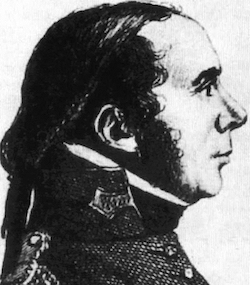General Charles-Louis-Dieudonné Grandjean

Born: December 29, 1768
Place of Birth: Nancy, Meurthe-et-Moselle, France
Died: September 15, 1828
Place of Death: Nancy, France
Arc de Triomphe: GRANDJEAN on the east pillar
Pronunciation:
The son of a lawyer, Charles-Louis-Dieudonné Grandjean followed in his father's footsteps and studied to become a lawyer at the University of Göttingen in Hanover, earning a doctorate in law. With the advent of the Revolution, Grandjean joined the National Guard and took command of the National Guard at Château-Salins. In May of 1792 he was commissioned as a sous-lieutenant in the 105th Infantry and sent to the Army of the Rhine. One year later Grandjean received a promotion to chef de bataillon in a battalion of grenadiers. More promotions followed as he served in the Army of the Rhine and the Army of the Moselle, for in 1794 he was promoted to chef de bataillon and in 1796 he was promoted to chef de brigade.
The next notable event in Grandjean's career came in March of 1799 in Italy when he fought the Austrians at the Battle of Pastrengo and led his men in taking a fortified redoubt. For his contributions and this feat, he was promoted to général de brigade on the battlefield. Grandjean continued to serve in Italy and that June he fought at the Trebbia where he was wounded twice. Next he joined Grouchy's division and fought at the Battle of Novi , where he took command of the division after Grouchy was captured. After serving under Victor and then Pouget in Italy, in April of 1800 Grandjean was sent back to the Army of the Rhine where he served under General Delmas. That May he fought at Engen, and a month later he took command of the division, replacing Delmas. The next month Grandjean served under Lecourbe at Neubourg before hostilities with the Austrians were temporarily ceased. When war resumed that winter, Grandjean served in Grouchy's division and fought at the Battle of Hohenlinden.
During the years of peace that followed, Grandjean was employed in the 5th and 4th military divisions. In February of 1805 he was promoted to général de division and then in March he took command of the 25th military division. When war broke out that August, Grandjean took command of a division in the reserve. In late 1806 Grandjean was placed under Marshal Mortier's command and he was ordered to disperse a Swedish corps at Ramkenhagen. In 1807 he served at the Siege of Danzig and then the Siege of Stralsund, but he was forced to lift the siege at Stralsund in April. Two months later Grandjean took command of a division in the Army of Observation under Marshal Brune and then in August he won at Anklam. That November he served in Pomerania as a commander of German troops from the Confederation of the Rhine.
In July of 1808 General Grandjean was recalled to Paris to then receive a new assignment to command a reserve division at Bayonne. In September he took command of a division in Moncey's III Corps, and not long thereafter he saw action, winning in October at Lerin and then serving at Tudela in November. Next Grandjean took command of a division in II Corps and then he served at the Siege of Saragossa.
In April of 1809 General Grandjean served in the Army of Germany on the Danube campaign and he was appointed commander at Landshut. After General Saint-Hilaire was badly wounded at the Battle of Aspern-Essling , Grandjean took command of his division in II Corps. Serving under General Oudinot at the Battle of Wagram , Grandjean was wounded twice during the course of the battle.
In recognition of his contributions, Grandjean was named a Baron of the Empire in January of 1810. That May he took command of the 14th military division until May of 1811 when he was named deputy commander at Danzig. In September of 1811 Grandjean took command of the 7th Division of German and Polish troops under Marshal Davout. In 1812 Grandjean and his division initially served as part of Davout's I Corps on the campaign against Russia, but in June they were moved under the command of Marshal Macdonald. In early 1813 he and his division were sent to help defend Danzig under the overall command of General Rapp. Grandjean served throughout the Siege of Danzig and he was taken prisoner when Rapp finally surrendered the fortress in January of 1814.
After Napoleon's abdication in 1814, Grandjean was released to return to France and he became a count. When Napoleon returned from exile in 1815 for the Hundred Days, he placed Grandjean in charge of the 17th infantry division in Rapp's V Corps. After the second Bourbon Restoration, Grandjean was placed on non-activity.
Bibliography
Updated June 2016
© Nathan D. Jensen